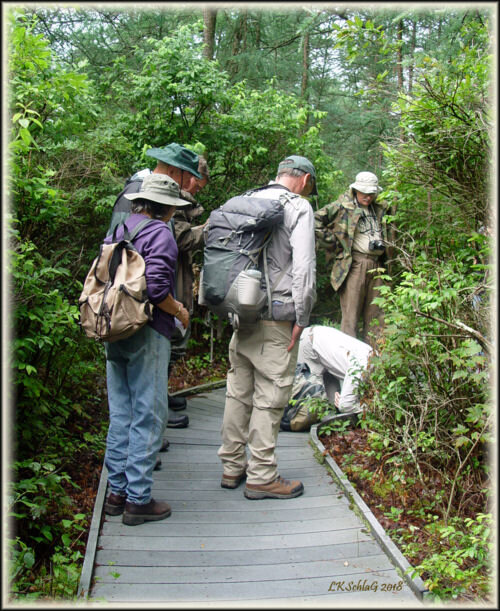
Field Notes


Native Plant Society of Northeastern Ohio
Kent Bog State Nature Preserve & Expansion in Portage County
23 June 2018
narrative by Judy Bradt-Barnhart
Eighteen people filled the preserve parking lot and lined the drive before meandering our way along the ½ mile recycled board walk. After marveling at the age diversity of the tamarack trees, a deciduous conifer that turns a brilliant gold in the fall. Kent Bog supports the largest and southernmost stand of tamaracks. Interspersed with the tamaracks were gray birch trees, another relict of the Ice Age. Both tree species classified as potentially threatened in Ohio. Gray birch has a more triangular shaped leaf than Ohio’s other birches as well as tight white bark, unlike the peeling white bark of the more northern paper birch.
gray birch bark, Betula populifolia
We often broke into smaller groups to discuss specific topics such as invasive species control with Chuck Fletcher, a Natural Areas and Preserves employee. Other groups were comparing shrub identification visible at head height from the board walk. Shrubs included highbush blueberry, chokeberry, winterberry and catberry with many already in fruit. Amongst the shrubs were leatherleaf and Virginia chain fern whose sori or spore capsules form a chain along the leaf veins and were just starting to form.
On the sphagnum mat we searched for the illusive carnivorous sundew while admiring the small cranberry, an endangered species.


three-way sedge, Dulichium arundinaceum Indian pipe, Monotropa uniflora
The original kettle hole is no longer visible but is replaced by a sedge meadow filled with several species of sphagnum moss and three-way sedge. The board walk looped back around through an oak woods on a sandy kame where we admired whorled loosestrife and Indian pipe just emerging.
Spotted turtles have been spotted in the preserve in the past but none were noted today. We weren’t the only ones on the board walk as several people passed us along the way. We made it back to the parking lot just as the rain started. We took refuge in our cars eating a quick lunch before the second part of our trip. With rain threatening again, instead of relocating to the southern edge of Portage Park District’s Kent Bog expansion, we decided to venture in from the preserve side to the north.
Land Steward Bob Lange led us directly to an oak woods growing on a sandy peninsula above the wetlands which occupy the same depression as the nature preserve. Portage Park expansion is 215 acres, 50 of which are the kettle hole bog extension. No tamaracks or gray birch have been found on the property to date, but hope is they will expand southward. Future plans call for opening the preserve to the public with trails.
With thunder rumbling in the distance, we decided to make our way back getting wet in the process. Most decided to proceed home to dry off while a few decided to stop at the nearby Triangle Lake Bog.
I highly recommend stopping at the preserve in October to enjoy the fall foliage.
Native Plant Society of Northeastern Ohio, Kent Bog State Nature Preserve & Expansion created 13.vii.2018
narrative: Judy Barnhart; proofreading: Charles Fletcher; layout & photographs: Lisa K. Schlag




















